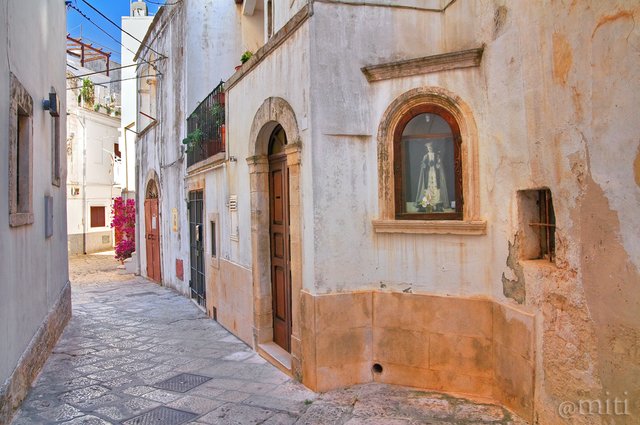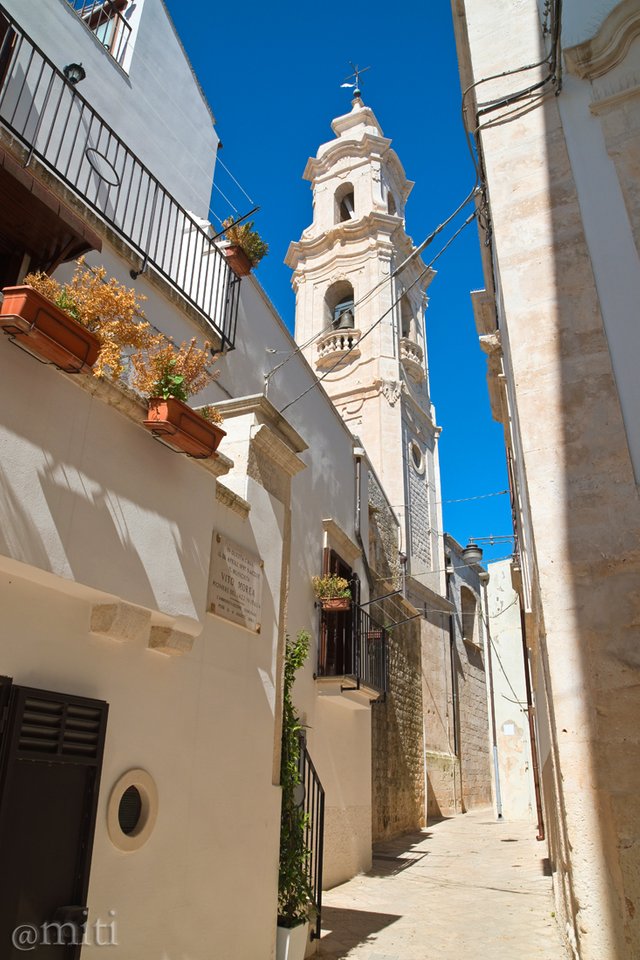A Journey through Italy: one photo every day #103 - NOCI [ENG/ITA]

Alleyway in the historical center (Author's photo - All rights reserved)
Vicolo del centro storico (Immagine dell'autore - tutti i diritti sono riservati)



Ciao a tutti,
questo è un viaggio attraverso l'Italia. Posterò una foto al giorno con una brevissima descrizione. Spero vi piaccia!

Noci è un borgo medievale della provincia di Bari, nella regione meridionale italiana della Puglia. Sorge sul promontorio delle Murge ed è circondata da trulli e grotte e da un importante patrimonio naturale di foreste e boschi.
Noci deve il suo nome a diversi alberi di noci che ricoprono quest'area, il cui patrimonio boscoso è certamente uno degli elementi naturalistici più tipici del suo territorio.
Il borgo ha radici antiche: secondo la tradizione, la cittadella militare esisteva già fin dal 565 ed era chiamato Castellum nucum, poi nel tempo è diventato un vero e proprio centro urbano, le cui principali attività sono sempre state pastorizia e l'agricoltura.
Gli studiosi fanno risalire le sue origini al Medioevo. Secondo una leggenda, a Filippo d'Angiò si doveva la costruzione della prima chiesa in segno di riconoscenza dopo essere stato riparato da un albero di noce durante una tempesta. Durante la dominazione angioina, Noci divenne "Universitas Regia" mentre con gli Acquaviva d'Aragona, fu elevato al rango di Ducato e fu collegato alla storia del Regno di Napoli.
Il centro storico presenta ancora elementi tipici medievali: basta camminare per i vicoli tortuosi per ammirare le case bianche, alte e strette, i vecchi palazzi impreziositi da fregi nobili come pure gli edifici religiosi e civili che hanno accompagnato la storia della città.
Da Porta Putignano i turisti possono arrivare a una piccola piazza con un giardino, dove si trova il monumento di Giuseppe Leonardo Albanese, martire della rivoluzione napoletana del 1799. Proseguendo oltre l'antico Palazzo di Corte raggiungono il cuore del borgo, caratterizzato dalla Piazza Plebiscito dove si affaccia la Chiesa Matrice dedicata alla Natività di Santa Maria, così come una serie di palazzi nobiliari e la Torre dell'Orologio, simbolo della città, eretta nel 1823. Percorrendo il resto del borgo, caratterizzato e suddiviso in contrade, è facile incontrare, balconate, scale, archi e le cosiddette “gnostre”, originali corti chiuse su tre lati e affacciate sulla strada.
Numerose sono anche le cappelle disseminate per le antiche vie: particolare quella di S. Leonardo del XVI secolo, che sorge su un preesistente saccello dell'università. Fuori le antiche mura, sono presenti i complessi conventuali di S. Domenico e quello dei Cappuccini dove ha sede la Biblioteca Comunale “Monsignore Amatulli”, entrambi fondati nel XVI secolo.
A pochi chilometri dal centro abitato, si trova la Chiesa di Santa Maria della Scala, con il convento benedettino e un laboratorio per il restauro di libri, dove diversi volumi, danneggiati durante l'alluvione di Firenze del 1966, sono stati ripristinati.
Cosa vedere: Il centro storico, la Chiesa Matrice, il monumento di Giuseppe Leonardo Albanese, il Palazzo di Corte, la Torre dell'Orologio, il "Gnostre", la Chiesa di San Leonardo, il Convento di San Domenico, il Convento dei Cappuccini, la Chiesa di Santa Maria della Scala.

Hello everyone,
I began a Photo Journey through Italy. I will post one photo every day with a little note of explanation. I hope you like it!

Noci is a medieval town in the province of Bari, in the southern Italian region of Puglia. It stands on Murge foreland and is surrounded by trulli and caves and by an important natural heritage with forests and woods.
Noci owes its name to several walnut trees once covering this area. Its woody heritage certainly is one of the most typical naturalistic elements in its territory.
Noci has old roots. According to tradition, the military citadel already existed as far back as 565 and was called Castellum Nucum; in time it became a true and proper urban centre, whose main activities have always been sheep-farming and agriculture.
Scholars trace its origins back to Middle Ages. According to a legend, Filippo d’Angiò had the first church built as a mark of gratitude after he was sheltered by a walnut tree during a storm. During Angevin domination, Noci became “Universitas Regia”. With the Acquaviva d’Aragona, it was raised to the rank of Dukedom and was connected with the history of the Kingdom of Naples.
The historic centre still presents typical medieval elements: one only has to walk down the winding alleys to admire the white, tall and narrow houses, the old palaces embellished by noble friezes as well as the religious and civil buildings which have accompanied the town’s history.
From porta Putignano tourists get to a small square with a garden, where there is the monument of Giuseppe Leonardo Albanese, martyr of the Neapolitan Revolution of 1799. Carrying on past the ancient Palazzo of Corte they reach the heart of the hamlet, characterised by the Piazza Plebiscito where the Matrix Church dedicated to st mary of the nativity overlooks, as well as a series of noble palaces and the Torre dell’Orologio, the town’s symbol, erected in 1823. Walking around the rest of the village, which is divided in streets, it is easy to come across balconies, staircases, arches and the so-called “gnostre”, original courts closed on three sides and overlooking the street.
There are also numerous chapels which are scattered around the old roads: a peculiar one is San Leonardo's, which dates back to the 16th century and stands on a pre-existing sacellum of the university. Outside the old walls there are the convent complexes of San Domenico and the one of the Cappuccini, which hosts the Biblioteca Comunale (Municipal Library) “Monsignore Amatulli”. Both convents were founded in the 16th century.
A few kilometres away from the inhabited centre, there is the Church of Santa Maria della Scala, with the Benedictine convent and a laboratory for the restoration of books, where several volumes, damaged during the flood in Florence in 1966, were restored.
Thing to see: The Historic Centre, the Matrix Church, the monument of Giuseppe Leonardo Albanese, the Palazzo of Corte, the Torre dell’Orologio, the "Gnostre", the Church of San Leonardo, the Convent of San Domenico, the Convent of Cappuccini, the Church of Santa Maria della Scala.

| Tipo di foto / Category | Paesaggio / Landscape view |
| Esposizione / Settings | 1/100 sec, ISO 200, f/9 |
| Camera | Nikon D5000 |
| Lente / Lens | Tamron SP 17-50mm f/2.8 XR Di II LD |
| Filtro / Filter | Polarizzatore Hoya / Hoya Polarizing filter |
| Cavalletto / Tripod | Manfrotto MKC3-P01 |
| Località / Location | Noci (Bari), Italia |
| Software | Photoshop / HDR |


Alleyway in the historical center (Author's photo - All rights reserved)
Vicolo del centro storico (Immagine dell'autore - tutti i diritti sono riservati)
Absolutely interesting read, just loved it and those beautiful captures are such historic, so amazing. The Bell Tower House is so perfectly captured, that's really awesome click.
Amazing sunshine
Great article I enjoy reading
such gorgeous colours on this photo 😊😊 enjoy your day, GREETINGS!
Thanks
Congratulations, Your Post Has Been Added To The Steemit Worldmap!
Author link: http://steemitworldmap.com?author=miti
Post link: http://steemitworldmap.com?post=a-journey-through-italy-one-photo-every-day-103-noci-eng-ita
Want to have your post on the map too?
Ah...ci sono stata!!!! Ho dormito dentro un trullo! Bellissimo
Si, l'ho fatto anche io anche se ad Alberobello.. un'esperienza unica :-)
Hi! Nice idea to do a photo tour, and loving the pictures!
I have 2 quick questions on your kit and process:
keep up the good work!
The quality of Sigma and Tamron is almost the same. I suggest you continue to use the Sigma lens. I Use Photomatix Pro for HDR.
Onestamente non sapevo che il nome si riferisse essenzialmente alle piante che circondano la città.
Posso solo immaginarmi la bellezza delle campagne che circondano l'abitato.
Si, è una zona che definirei un polmone verde sulla murgia.
It seems you had a nice time in Bari and your photos are lovely
It seems you had a
Nice time in Bari and your
Photos are lovely
- nancie
I'm a bot. I detect haiku.
I live in Bari... so everyday is a nice day :D
@miti i.like the beautifull streets and you know the game counter strike this street looks like game graphics